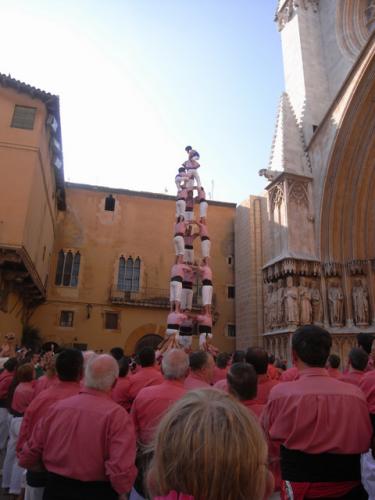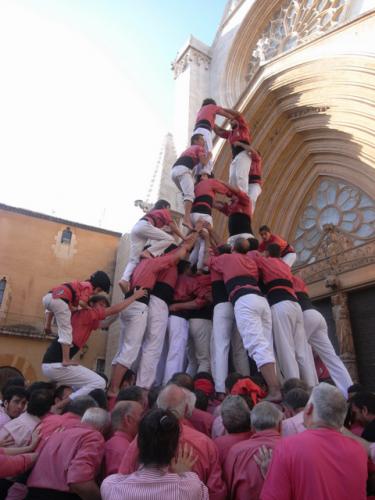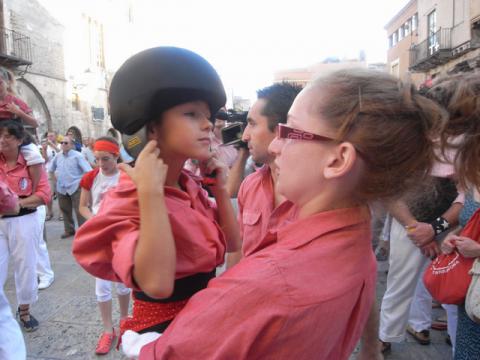These photos were taken in Tarragona, Spain. This is a traditional “castell” that is built at festivals in Spain. It’s basically a human pyramid on steroids.

Although I was lucky to happen upon this event, it’s a big deal, and people had been planning to come to this for a while. There were hundreds of people filling the square, the giant church, ambulances in case of injuries, bands playing all over the square. Mind you, the square and the church seemed a whole lot smaller when the castell went up. The whole crowd went silent - all but one man, who was screaming instructions at the climbers. When the last person reached the top, the crowd rejoiced, almost as if they had all been holding their breath. The man still screaming orders, the bands start playing, and everyone cheers. The last person clambers down, and immediately they prepare to build the next tower.
There are many different types of castell, but the one pictured here is a 7 layer castell with a ‘pinya’. The pinya is a mob of people crowded around the bottom, acting as the base and supporting the tower. If you look at the very base of the tower, you can see hands reaching up to the second level, securing them, making sure they’re steady.

There are several people involved in making this tower work: the ‘cap de colla’, ‘cap de pinya’ and ‘enxaneta’. The ‘cap de colla’ remains at the bottom of the tower and make sure everything remains safe. As the tower is built, he shouts orders to those climbing, telling them what to watch out for, telling them what level to stop at, and if they should retreat. The ‘cap de pinya’ takes care of the ‘pinya’, making sure that the people are spread about evenly, and that the base is strong enough to support the tower. As you can see in this photo, the ‘enxaneta’ is a small child that stands at the top of the tower. When the enxaneta reached the top, the tower is considered completed.

Everyone on the ‘team’ wears white pants, a shirt with their ‘team’ color, and a black sash around their waist. Each city or town has its own team and it’s convenient that they can be distinguished, as sometimes there are competitions or collaborations. The event pictured in this photo was a friendly collaboration between two teams. The red are from Tarragona, and the red
and white stripes, whose shirts seem pink from afar, are from a neighboring town. The sash they’re all wearing is good for two reasons: it supports their lower backs, which, for the people on the bottom levels, are under the weight of up to 7 or 8 people; it also serves as a handhold for the people climbing up. None of them wear shoes, as shoes could possibly injure the people they climb on. Also, being barefoot gives them better balance. Castells were recently declared by UNESCO to be one of the Masterpieces of the Oral and Intangible Heritage of Humanity. And for good reason - these towers are impressive to even the most seasoned climbers.
After attending school on three continents, Anne Driscoll is finishing her high school career as an unschooler. She now speaks Spanish and Chinese fluently. Anne spends much of her time abroad learning about different cultures. She is currently focusing on Mapuche traditions and lemurs. In addition, she enjoys heliophysics, languages, and 3D printers.
All photos courtesy and copyright Anne Driscoll
